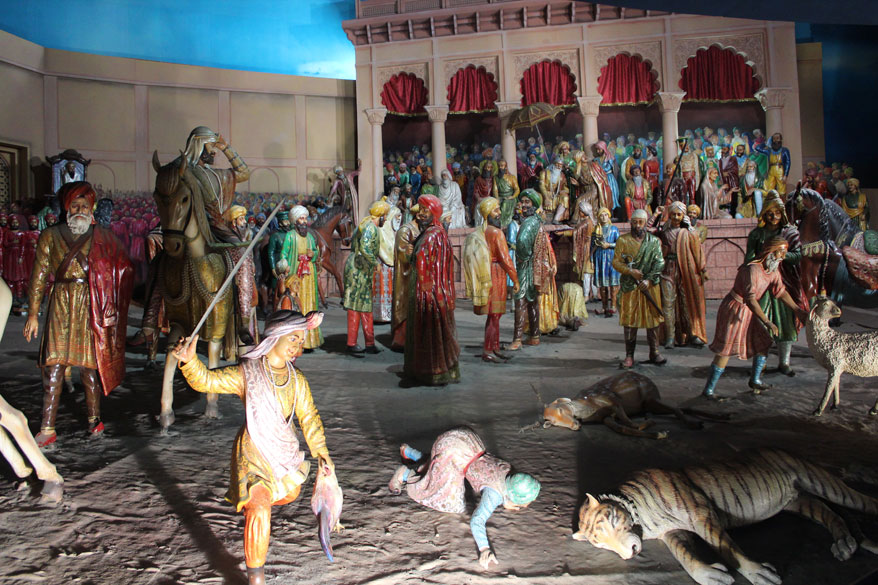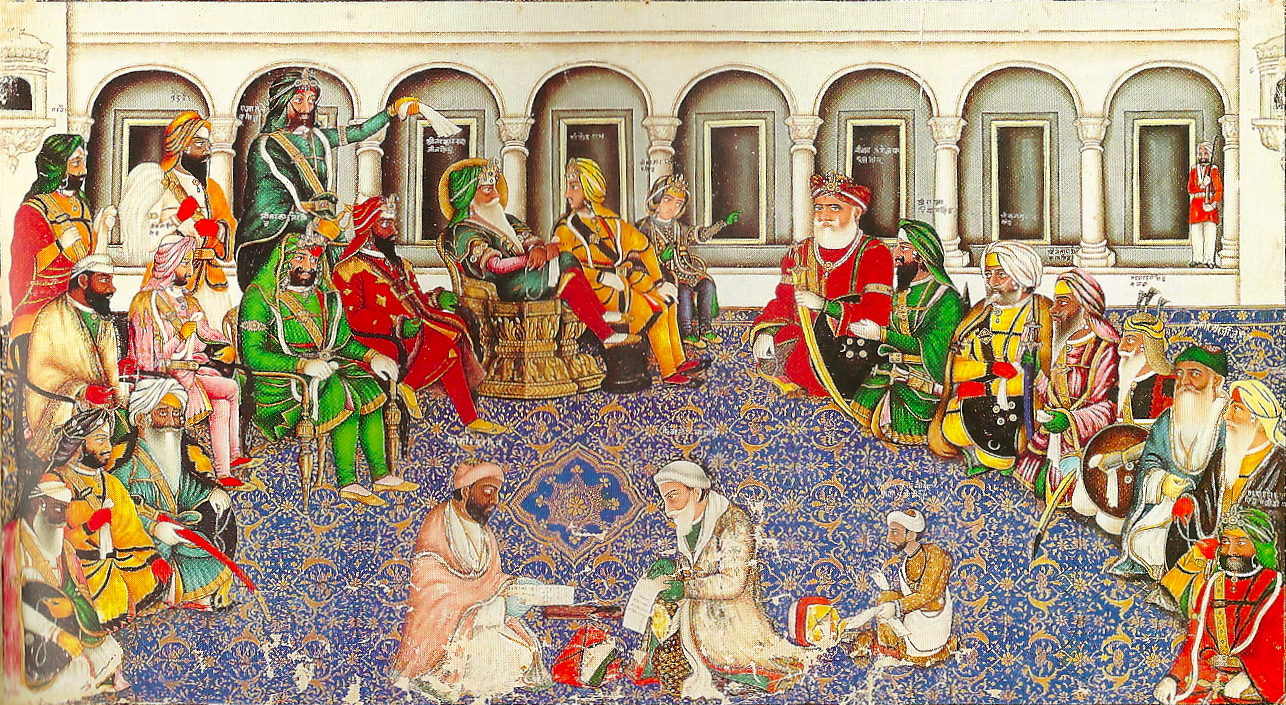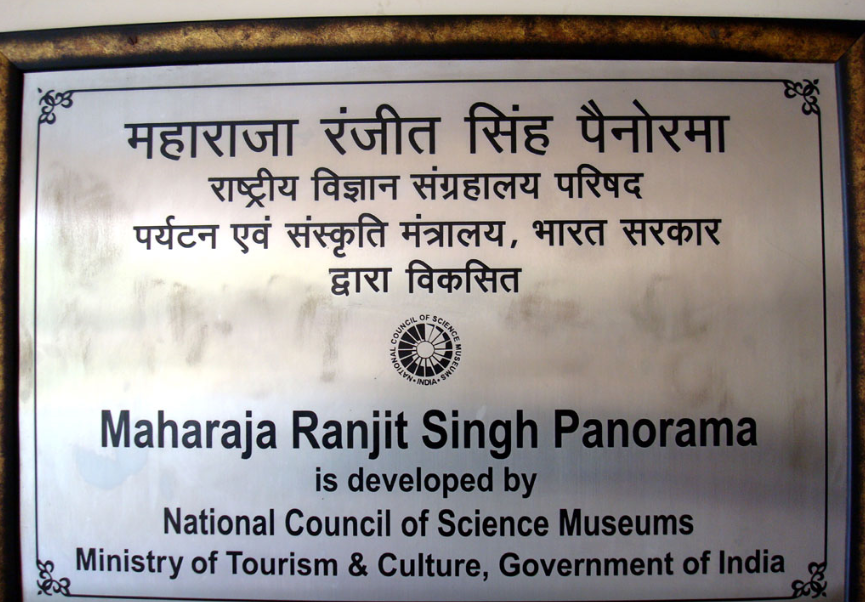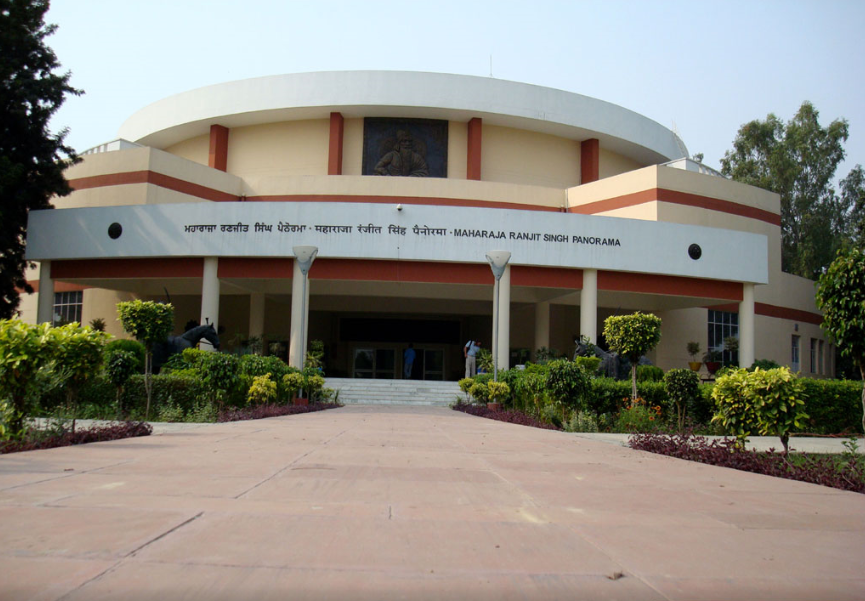Maharaja Ranjit Singh Panorama
Maharaja Ranjit Singh's reign was also known for all round development, secular values and patriotic fervour. Keeping all these aspects in mind, the Amritsar has come up with many such things that reminds one of Maharaja Ranjit Singh's rule. Maharaja Ranjit Singh The National Council of Science Museums in cooperation with the State government has recently set up Maharaja Ranjit Singh Panorama, which is only second of its kind in the country. Spread on a sprawling 4.5 acres of land in the historic Rambagh heritage Garden, the panorama with its long, cylindrical architecture, is an all-captivating marvel for visitors.
Inside, there are three sections that take a person back in time through 200 years of Sikh History.
The main attraction, however, is the life-like panorama of the various major wars, which comes alive through the 12 meters high and 100 meters long panoramic painting depicting six major battle expeditions of Maharaja Ranjit Singh.
At the entrance to the main panorama, a visitor comes across the most-attractive Darbar-e-Khalsa (or, Court of Khalsa) of Ranjit Singh. The scene is the replica of a rare picture adorning the walls of the Lahore Fort.
The battle expeditions were presented with a lively three dimensional diorama on the foreground consisting of many mannequins of warriors, soldiers, horses, camels, weapons and so on.
The battles include his victory at Lahore, the capture of Kangra, the battle for the fort of Attock, victory at Multan, the conquest of Kashmir and the battle of Naushera.Lely Horse of Maharaja
The Maharaja's Grand Durbar at Lahore has also been recreated in the panorama hall through a large three dimensional presentation where Maharaja is seen with his chiefs, nobles and also the poor and destitute celebrating Dussehra with a great zeal and zest.
The other landmark is the vibrant life span of the Maharaja Ranjit Singh. It has been presented through eight smaller dioramas in the ground floor halls. Theses include Maharaja in childhood, Maharaja's marriage, capture of Zamzama, gold cladding of Shri Harmandir Sahib, acquisition of Koh-i-noor and modernization of his army.
Five touch-screen computers alongside the main hall of the Panorama have been installed to help visitors to identify the important Sikh generals and courtiers of the Maharaja.
Maharaja Ranjit Singh was a Sikh born in 1780 in Gujranwala in modern day Pakistan, into the Sansi-Sandhawalia family. Inside Panorama
At that time, much part of Punjab State was under Sikh rule who had divided the territory among factions known as misls. Ranjit Singh's father Mahan Singh was the commander of the Sukerchakia misl and controlled a territory in west Punjab based around his headquarters at Gujranwala.
Ranjit Singh succeeded his father at the young age of 12. After several campaigns, his rivals accepted him as their leader, and he united the Sikh factions into one state and he took the title of Maharaja on April 12, 1801 (to coincide with Baisakhi day), with Lahore having served as his capital from 1799. In 1802 he took the holy city of Amritsar. He then spent the following years fighting the Afghans, driving them out of western Punjab. He also captured Pashtun territory including Peshawar. Maharaja also hired European mercenaries to train his troops, creating a powerful military force whose presence delayed the eventual British colonization of Punjab.

The hallmark of the art of Maharaja Ranjit Singh is thus its truthfulness. It is of the earthly earth. And, in spite of the import of some of the painters from the Pahari courts, the abundance of portraiture shows how almost everyone, including the Maharaja, was in search of an identity in their new exalted status, which they had acquired from modest origins in the villages of the Punjab plains. Thus, every expression under the patronage of Ranjit Singh and his nobles, shows a vitalist urge for freedom to open out to life, and more life, in the midst of things of beauty which may please the eyes, make the heart glow and intensify the emotions, says Mulk Raj Anand

OUR recalls of the heritages of the past are not from the wish to revive bygone splendours, which cannot come back. We wish to show how the purposive will of men in certain periods of our history, have created, out of anarchy and disorder, glories which heightened the quality of life and which may inspire our renascent efforts today.
Although there was no period in the history of our sub-continent, when the vast landscapes did not see infiltrations, invasions and onslaughts from without, and constant disruption through internecine quarrels of one chieftain with another, there were a few periods during which heroes appeared, who could, by their practical genius, insight and visionary outsight, connect the fighting factions, reorganise the shattered principalities, evolve some kind or order, and restore the faith of vast peoples in life itself.

The Maharaja with Kharak Singh, Sher Singh, Naunehal Singh and (standing behind) Dhian SinghOne of the last such heroes of feudal India was Ranjit Singh, who became Maharaja of Punjab in his teens, and consolidated and Empire, stretching from the Sutlej on the south to Afghanistan in the north, Kashmir and Ladakh on the east to Sind on the west. And, in spite of the rigours of the bitter struggles to unite the disparate elements, to subdue the recalcitrant princes, nobles and landlords, with all the difficulties of bypassing intrigues, punishing treachery and crating a relatively just and humane order, he released the creative energies of people to build buildings worthy of the new empire, evolve the arts for the enjoyment of the good life, and recognise the beauty of well-made things.
There is no gainsaying the fact that, though he was essentially a military genius and therefore roughened by the ups and downs of battles, as also forced to be hard-headed in administering the new kingdom, he became daily involved in integrating men and women into togetherness. And he could withdraw into his own zenana and seek to recreate himself, by witnessing dance, hearing music, hold durbar, preferably in the garden, receive the craftsmen and encourage them to produce gifts worthy of exchange between himself and the representatives of the powers around him.
It is likely that the patronage he gave to the artisans was in emulation of the example set by the previous monarchs, specially the Mughals. But there seems to have been, behind the daily conversations with his nobles, organising of the army, appointing officers to collect revenue and sundry preoccupations of the monarchical routine, his own personal need to refurbish the faith in himself.
In the various gestures he made, to involve the sanctions of humaness from the first Master of the Sikh faith, Guru Nanak, he seems to show his aspirations to build the personal myth of a man, who had not only shaped an empire with his sword, but brought congregations of peoples of different religions through genuine and heartfelt tolerance.



































